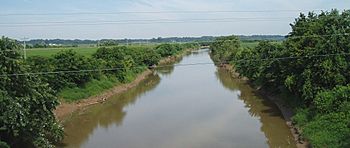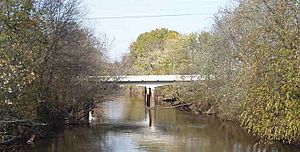Forked Deer River facts for kids
Quick facts for kids Forked Deer River |
|
|---|---|

The South Fork of the Forked Deer River near Halls, Tennessee
|
|
| Country | United States |
| State | Tennessee |
| Physical characteristics | |
| Main source | 35°59′51″N 89°26′08″W / 35.99750°N 89.43556°W |
| River mouth | Obion River, Mississippi River 230 ft (70 m) 35°55′42″N 89°35′12″W / 35.92833°N 89.58667°W |

The Forked Deer River is a river system in West Tennessee, United States. It helps drain the central part of this region. Locals say the first word of the river's name with two syllables, like "Fork-ed."
Contents
Exploring the Forked Deer River
The Forked Deer River is made up of several streams and their smaller branches. These include the North Fork, Middle Fork, and South Fork.
Long ago, much of the land around the Forked Deer River was wetlands. Wetlands are areas where the land is covered by water, like swamps or marshes. Over time, many of these wetlands were drained. This was done to create more land for farming.
How the River Changed
To help with farming, many parts of the Forked Deer River and its smaller streams were "channelized." This means they were straightened and deepened. This work was often done by a state group called the Obion-Forked Deer Basin Authority.
Today, there are rules to protect wetlands. A policy called "no net loss" means that if wetlands are drained for new projects, new wetlands must be created somewhere else. These new areas are called "mitigation lands."
Most of the river's water now flows into the Obion River. The Obion River then flows into the mighty Mississippi River. Some other streams in the Forked Deer system flow directly into the Mississippi River. Even after new channels were made, some old river paths still have a lot of water, especially after heavy rains.
History and Fun Facts
In the early 1800s, barges and small riverboats used to travel on the Forked Deer River. They could go as far upstream as the city of Jackson, Tennessee. But over time, the river became filled with silt. Silt is fine dirt and mud, often from farm runoff. This made it hard for boats to travel.
Because of the silt, people worked to straighten and deepen the river. This continued until the 1970s.
Today, where the river's path was changed, many small "finger lakes" were left behind. These lakes are very popular for fishing. People enjoy catching crappie and bass in these quiet waters. The main river itself is now a slow-moving channel, and it doesn't have many scenic views.
Forked Deer River Tributaries

